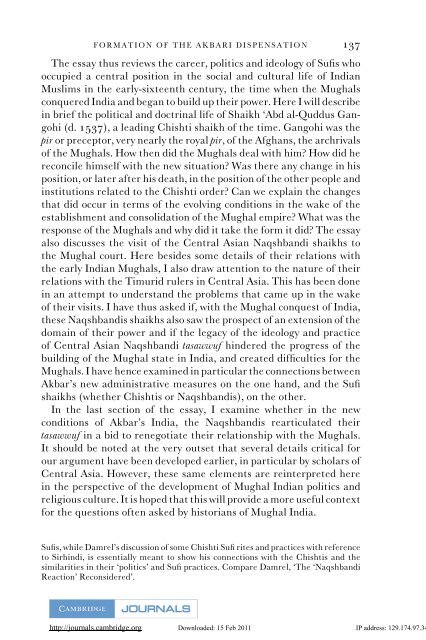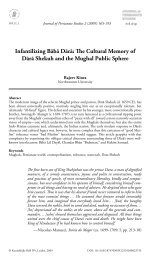The Mughals, the Sufi Shaikhs and the Formation of the Akbari ...
The Mughals, the Sufi Shaikhs and the Formation of the Akbari ...
The Mughals, the Sufi Shaikhs and the Formation of the Akbari ...
Create successful ePaper yourself
Turn your PDF publications into a flip-book with our unique Google optimized e-Paper software.
FORMATION OF THE AKBARI DISPENSATION 137<br />
<strong>The</strong> essay thus reviews <strong>the</strong> career, politics <strong>and</strong> ideology <strong>of</strong> <strong>Sufi</strong>s who<br />
occupied a central position in <strong>the</strong> social <strong>and</strong> cultural life <strong>of</strong> Indian<br />
Muslims in <strong>the</strong> early-sixteenth century, <strong>the</strong> time when <strong>the</strong> <strong>Mughals</strong><br />
conquered India <strong>and</strong> began to build up <strong>the</strong>ir power. Here I will describe<br />
in brief <strong>the</strong> political <strong>and</strong> doctrinal life <strong>of</strong> Shaikh ‘Abd al-Quddus Gangohi<br />
(d. 1537), a leading Chishti shaikh <strong>of</strong> <strong>the</strong> time. Gangohi was <strong>the</strong><br />
pir or preceptor, very nearly <strong>the</strong> royal pir, <strong>of</strong> <strong>the</strong> Afghans, <strong>the</strong> archrivals<br />
<strong>of</strong> <strong>the</strong> <strong>Mughals</strong>. How <strong>the</strong>n did <strong>the</strong> <strong>Mughals</strong> deal with him How did he<br />
reconcile himself with <strong>the</strong> new situation Was <strong>the</strong>re any change in his<br />
position, or later after his death, in <strong>the</strong> position <strong>of</strong> <strong>the</strong> o<strong>the</strong>r people <strong>and</strong><br />
institutions related to <strong>the</strong> Chishti order Can we explain <strong>the</strong> changes<br />
that did occur in terms <strong>of</strong> <strong>the</strong> evolving conditions in <strong>the</strong> wake <strong>of</strong> <strong>the</strong><br />
establishment <strong>and</strong> consolidation <strong>of</strong> <strong>the</strong> Mughal empire What was <strong>the</strong><br />
response <strong>of</strong> <strong>the</strong> <strong>Mughals</strong> <strong>and</strong> why did it take <strong>the</strong> form it did <strong>The</strong> essay<br />
also discusses <strong>the</strong> visit <strong>of</strong> <strong>the</strong> Central Asian Naqshb<strong>and</strong>i shaikhs to<br />
<strong>the</strong> Mughal court. Here besides some details <strong>of</strong> <strong>the</strong>ir relations with<br />
<strong>the</strong> early Indian <strong>Mughals</strong>, I also draw attention to <strong>the</strong> nature <strong>of</strong> <strong>the</strong>ir<br />
relations with <strong>the</strong> Timurid rulers in Central Asia. This has been done<br />
in an attempt to underst<strong>and</strong> <strong>the</strong> problems that came up in <strong>the</strong> wake<br />
<strong>of</strong> <strong>the</strong>ir visits. I have thus asked if, with <strong>the</strong> Mughal conquest <strong>of</strong> India,<br />
<strong>the</strong>se Naqshb<strong>and</strong>is shaikhs also saw <strong>the</strong> prospect <strong>of</strong> an extension <strong>of</strong> <strong>the</strong><br />
domain <strong>of</strong> <strong>the</strong>ir power <strong>and</strong> if <strong>the</strong> legacy <strong>of</strong> <strong>the</strong> ideology <strong>and</strong> practice<br />
<strong>of</strong> Central Asian Naqshb<strong>and</strong>i tasawwuf hindered <strong>the</strong> progress <strong>of</strong> <strong>the</strong><br />
building <strong>of</strong> <strong>the</strong> Mughal state in India, <strong>and</strong> created difficulties for <strong>the</strong><br />
<strong>Mughals</strong>. I have hence examined in particular <strong>the</strong> connections between<br />
Akbar’s new administrative measures on <strong>the</strong> one h<strong>and</strong>, <strong>and</strong> <strong>the</strong> <strong>Sufi</strong><br />
shaikhs (whe<strong>the</strong>r Chishtis or Naqshb<strong>and</strong>is), on <strong>the</strong> o<strong>the</strong>r.<br />
In <strong>the</strong> last section <strong>of</strong> <strong>the</strong> essay, I examine whe<strong>the</strong>r in <strong>the</strong> new<br />
conditions <strong>of</strong> Akbar’s India, <strong>the</strong> Naqshb<strong>and</strong>is rearticulated <strong>the</strong>ir<br />
tasawwuf in a bid to renegotiate <strong>the</strong>ir relationship with <strong>the</strong> <strong>Mughals</strong>.<br />
It should be noted at <strong>the</strong> very outset that several details critical for<br />
our argument have been developed earlier, in particular by scholars <strong>of</strong><br />
Central Asia. However, <strong>the</strong>se same elements are reinterpreted here<br />
in <strong>the</strong> perspective <strong>of</strong> <strong>the</strong> development <strong>of</strong> Mughal Indian politics <strong>and</strong><br />
religious culture. It is hoped that this will provide a more useful context<br />
for <strong>the</strong> questions <strong>of</strong>ten asked by historians <strong>of</strong> Mughal India.<br />
<strong>Sufi</strong>s, while Damrel’s discussion <strong>of</strong> some Chishti <strong>Sufi</strong> rites <strong>and</strong> practices with reference<br />
to Sirhindi, is essentially meant to show his connections with <strong>the</strong> Chishtis <strong>and</strong> <strong>the</strong><br />
similarities in <strong>the</strong>ir ‘politics’ <strong>and</strong> <strong>Sufi</strong> practices. Compare Damrel, ‘<strong>The</strong> ‘Naqshb<strong>and</strong>i<br />
Reaction’ Reconsidered’.<br />
http://journals.cambridge.org Downloaded: 15 Feb 2011 IP address: 129.174.97.34






